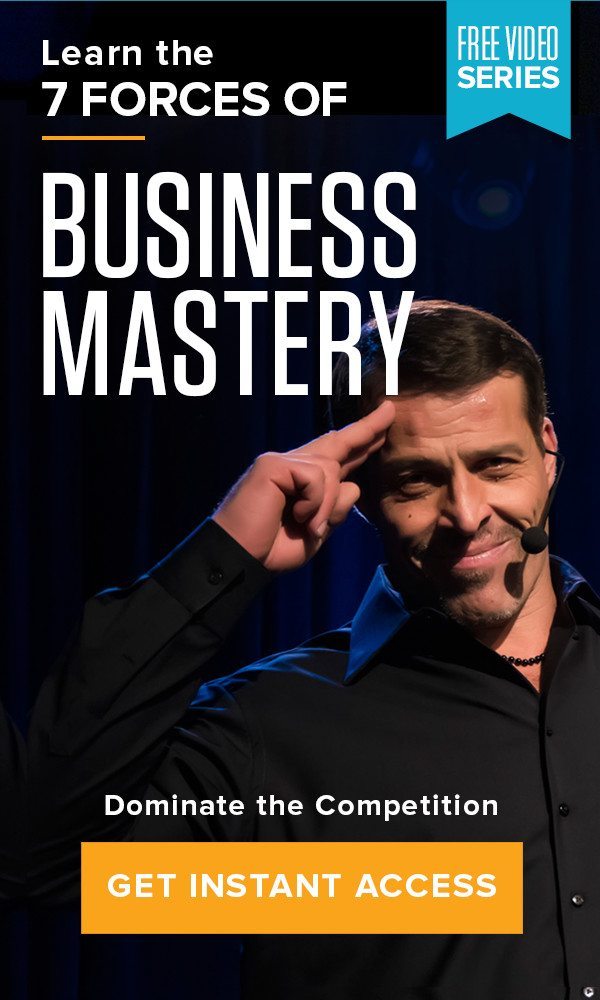Team Tony cultivates, curates and shares Tony Robbins’ stories and core principles, to help others achieve an extraordinary life.
How to create a growth strategy
6 steps to making a plan for explosive growth
Most business owners think that to create explosive growth they must make massive changes – explosive growth has to come from combustive action, right? In reality, business growth strategies are small, incremental improvements in certain areas of the company that are lacking. You’ll go through many growth strategies over the course of expanding your business, but there are several principles that apply to all of them.
What is a growth strategy?
A growth strategy is a plan that businesses follow in order to gain market share. It’s typically a long-term plan, and can even sometimes come at the expense of short-term profit. That’s because some types of growth strategies require the business to divert funds from its usual operations to focus on new areas, which may not see returns immediately. But not all growth strategies come with big risks.
Market penetration strategy
Means focusing on your current product or offering and growing its use within your current market. Because you’re not developing new products or entering new markets, this is the lowest-risk strategy. You might increase your marketing budget, lower your prices or bundle products in order to achieve market penetration.
Market expansion strategy
Is when a business takes its current product or offering into a new market. Businesses often do this when growth opportunities in the current market are limited. Market expansion is eventually required for most businesses – if you don’t find new markets, revenue will always be limited.
Product development strategy
Means focusing resources on improving current products. This growth strategy is a part of constant and strategic innovation and providing more value than anyone else. Businesses must find new ways to fulfill customer needs and develop better, faster, cheaper technology – or get left behind.
Diversification strategy
Carries the most risk. This is when a company decides to create an entirely new product – a dog food company starting to make leashes or a paper company making printers. When the markets are related, it’s called horizontal diversification. If the markets are not related – like an auto manufacturer getting into the telecoms industry – it’s called conglomerate diversification.
Why do I need a growth strategy?
As a business owner, at any given moment, a million things can be competing for your attention. Creating a growth strategy is the best way to focus your energy on what matters most for your business: driving revenue and capturing new customers. Constant optimization and maximization – Force #6 of Tony’s 7 Forces of Business Mastery – is all about going back to the core processes of your business and determining what’s preventing your growth. From there, you can make a plan.
A growth strategy also allows you to mobilize your team toward the same goal. When you provide a vision for your company that directs its energy toward a specific result, the ease in achieving organic yet explosive growth can be astounding.
Take serial entrepreneur Laurence Hallier. He developed and delivered over $1 billion in real estate projects in the 2000s, then went on to found Show Media, the top provider of digital interactive advertising screens in taxicabs. His company has been featured three times on the Inc. 500 Fastest Growing Companies in America.
How was he able to accomplish this impressive growth for his businesses? Laurence clearly knows how to leverage business growth strategies. He has attended Tony Robbins’ Business Mastery multiple times, each time taking back different insights and action items on business model innovation. Hear Laurence speak more about the impact of this event:
Six steps to creating business growth strategies
What does Laurence know that others don’t? To create and implement a successful growth strategy, you need to follow these six steps.
1. Develop a growth mindset
Marketing expert Jay Abraham states that an incredibly important part of geometric growth is business owners getting out of their own way. Jay’s worked with numerous entrepreneurs who have limited growth ability because they have assumptions about what their businesses can and can’t do. These assumptions are built on limiting beliefs that prevent them from growing past a certain point.
When you realize that your capacity as a company is much higher than you ever imagined, it disrupts your old way of thinking. Jay suggests addressing these limiting beliefs through a combination of meditation, neurofeedback and exercise to calm your mind and create an atmosphere for developing a growth mindset.
2. Become a leader
The highest achievers go beyond developing a growth mindset. They are able to focus, execute and lead others in an inspiring way. That’s because they have clarity of vision – they attack their goals and are committed to preparing for “the game.” They study the strengths and weaknesses of the competition, then develop a game plan that leverages their own skills and expertise to bring about the desired outcomes. They recognize the power of their specific skill set and execute these skills when it matters most.
They also have a mission or purpose that’s larger than themselves. They communicate their vision with passion and set an example by living their purpose every day. Because what is a growth strategy if not a vision for your company’s future? Stepping into that winning mindset – for yourself and for your team – is a must when trying to achieve explosive growth.
3. Choose your growth strategy
The four business growth strategies discussed above are typically considered in that order: market penetration, market expansion, product development, then diversification. Because the strategies are in order of risk, it makes sense for small businesses to start at the lowest risk and work up to a high-risk, high-investment strategy like diversification. As you implement one growth strategy and find success, the limits of the market will necessitate moving on to the next strategy.
If you’re not sure which growth strategy to choose, start by defining your short- and long-term goals. Make them specific and achievable, like bringing three new products to market this year or increasing sales by 20 percent. Then categorize each goal into one of the four growth strategies and prioritize them according to which would help you achieve the most explosive growth in market share. Now you know where to focus your energy.
4. Foster a productive work environment
As a business leader, you know that high-performance organizations foster successful innovators, thanks to the alignment of several vital forces. A culture of innovation, efficient business processes (including developing strong company values), powerful performance systems and team competency and behavior all work in harmony inside the world’s top companies. Keeping your team happy is key to putting them in the right mindset to create explosive growth. If your employees are unhappy at work, they won’t have the drive and passion needed to implement your growth strategy.
Agility is also essential. To become a constantly evolving organization, there must be flexibility at all levels. A business that succeeds is one that balances mindful scaling with geometric growth. Explosive growth can be a game-changer for your business, but deliberately moving your brand forward through well-thought-out steps you can repeat will lead to greater success in the long run.
5. Measure and optimize
Opportunities for maximization can be found in almost every area of the business: lead generation, sales and prospecting, sales conversion, changes to your offers and more. How do you know if your growth strategy is working? You can’t manage what you don’t measure. Determine measurable indicators of success and document all of your processes, then analyze your results.
Jay suggests that you also analyze your team members during this step of the process. He developed the Performance Enhancement Quotient (PEQ), a method of study and development that extracts the best practices from your team’s top performers so they can be quantified and taught to others in that department. His research suggests that, in most companies, 20% of the employees are achieving 80% of the results. With the PEQ, you can dramatically increase the results of everyone in the company, which also leads to improvements in company culture as everyone is acknowledged and elevated rather than just the top performers.
6. Learn from your experience
Learn from your experience and results and understand that obstacles are usually just opportunities in disguise. Everyone fails sometimes, be it in a championship game or in business. Don’t be afraid of failure. Instead, evaluate your successes and failures and mentally prepare to create a new growth strategy.
- If you lost, how will you keep pushing your practices forward?
- If you won, what factors contributed to your success?
- What were the key decisions you made, for better or worse?
- How will you maintain your strengths and build on your weaknesses?
Jay states that being a fluid company helps you learn from your mistakes and make tweaks that aren’t disruptive to your geometric growth. In the past, many leaders thought they needed to make dramatic pivots to get around formidable obstacles. However, laying off half their team or making huge changes to their business models led to failure more often than a successful growth strategy. Though Jay believes that no one and nothing stays constant, he advocates that building a cross-functional team and taking other measures to stay flexible will allow you to respond to economic changes and customer demand without having to completely rethink your business growth strategies.





